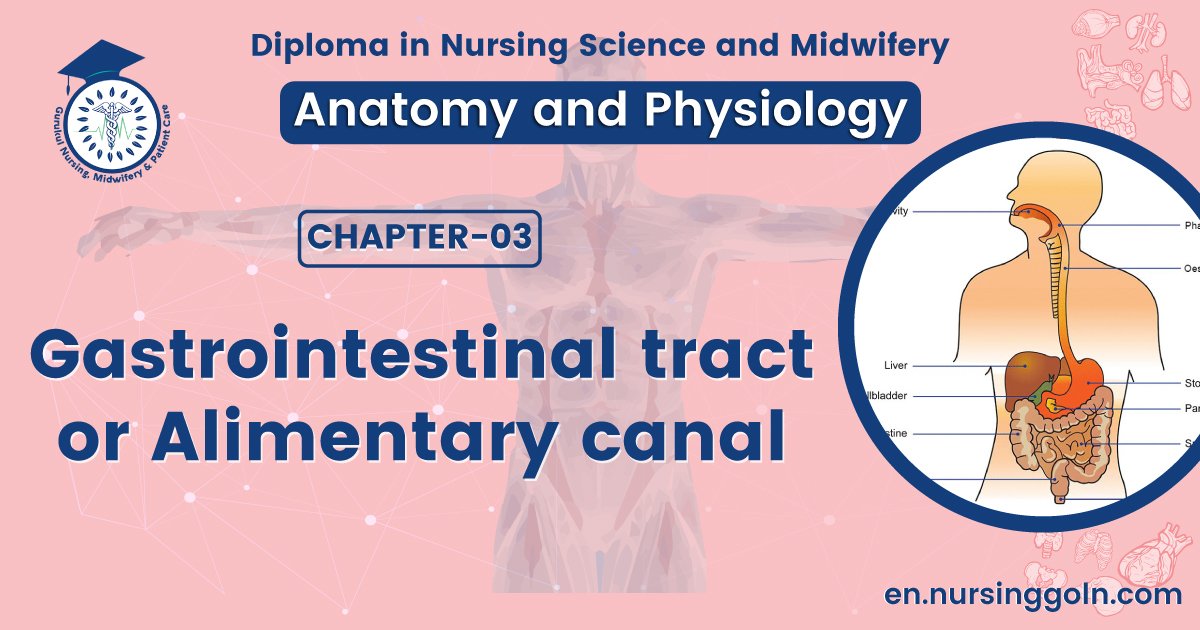Gastrointestinal tract or Alimentary canal-The course is designed for the basic understanding of anatomical structures and physiological functions of human body, musculoskeletal system, digestive system, respiratory system; cardiovascular system; urinary system, endocrine system, reproductive system, nervous system, hematologic system, sensory organs, integumentary system, and immune system.The aim of the course is to acquire knowledge and skills regarding anatomy and physiology.
Gastrointestinal tract or Alimentary canal

Gastrointestinal tract also known as alimentary canal is basically a muscular tube extending from mouth to the anus and compromises following parts:-
1. Mouth: Mouth is loosely used term to denote the external opening and for the cavity it leads to The cavity containing anterior two-third of tongue and teeth is the mouth cavity or oral cavity or buccal cavity
a) Tongue: Tongue in the digestive system, plays two important roles: Tells the taste of food and Helps in chewing and swallowing of food.
b) Teeth: Teeth are accessory organ of digestion which help in crush grind and chewing the food.
2. Pharynx: When food is swallowed, it passes from the mouth into the pharynx, a funnel-shaped tube that is composed of skeletal muscle and lined by mucous membrane. It extends from the internal nares to the esophagus posteriorly and the larynx anteriorly
3. Oesophagus: The oesophagus is a muscular tube lined with stratified squamous epithelium that lies posterior to the trachea. It begins at the end of the laryngopharynx, passes through the mediastinum and diaphragm, and connects to the superior aspect of the stomach.
It transports food to the stomach and secretes mucus. At each end of the esophagus, the muscularis forms two sphincters- the upper esophageal sphincter (UES), which consists of skeletal muscle, and the lower esophageal sphincter (LES), which consists of smooth muscle.

4. Stomach: Stomach is a J-shaped hallow muscular bag connected to the oesophagus at its upper end and to the duodenum at the lower end. The stomach is the most elastic part of the Gl tract and can accommodate a large quantity of food, up to about 6.4 liters (6 qt).
5. Small intestine: The small intestine averages 25 cm (1 in.) in diameter, its length is about 3 m (10ft) in a living person and about 6.5 m (21 ft) in a cadaver due to the loss of smooth muscle tone after death.
It is a long tubular s.tructure which can be divided into three parts:-
- Duodenum: is the first part of small intestine. It is “C” shaped and measures about 25 cm in length.
- Jejunum: is the middle part of the small intestine, is about 2 meters long and
- fleum: is the last part of small intestine, is about 3 meters long.
6. The large intestine: is averages about 6.5 cm (2.5 in.) in diameter and about 1.5 m (5 ft) in length. It extends from the leum to the anus and is attached to the posterior abdominal wall by its mesentery. The large intestine has four principal regions:
- Caecum,
- Colon,
- Rectum, and
- Anal canal
Concept about Pharynx

(Ref:- K. Indu, Text book of Anatomy and Physiology for Nurses, I edition,P-255.256 +J. TORTORA, 8th edition, P-506)
Read more:
